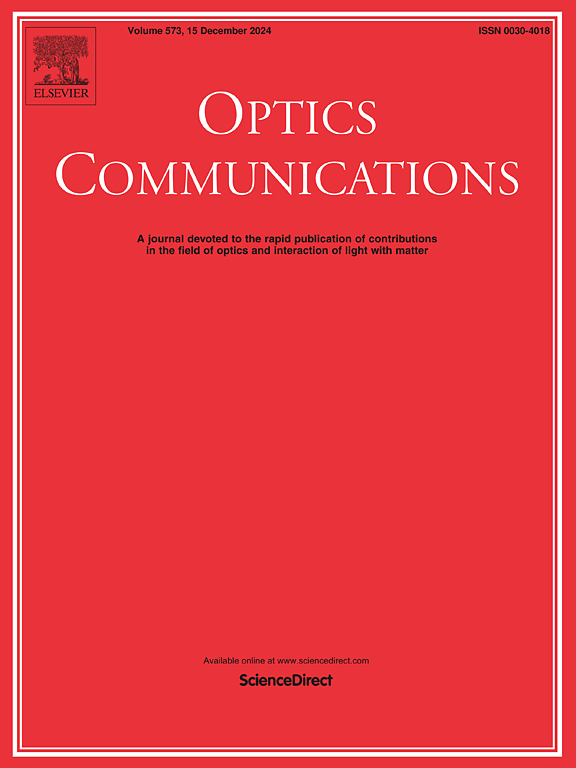Co-transmission of optically-carried 5G NR signal and over 14-W power light via standard single-mode fiber
IF 2.2
3区 物理与天体物理
Q2 OPTICS
引用次数: 0
Abstract
Co-transmission of optically-carried broadband wireless communication signal and power light in standard single-mode fiber (SSMF) is the supporting technology for realizing remotely-powered antenna units in the next-generation wireless communication networks. Here, we experimentally demonstrate the co-transmission of optically-carried fifth-generation new radio (5G NR) signal and over 14-W power light via a spool of SSMF with a length of 1 km. Thereinto, the optical power transmission efficiency (OPTE), which is restricted by stimulated Brillouin scattering, is increased via extending the linewidth of the power light to 1 nm. Additionally, the in-band interference and the signal-to-noise ratio (SNR) degradation of the optically-carried 5G NR signal, which are attributed to the noise transference and the modulation instability induced by the Kerr effect and the stimulated Raman scattering effect, are suppressed through group-velocity dispersion management via carefully designing the wavelengths of the signal light and the power light. In the simulation, a 7-dB reduction in the noise floor and a significant rejection of the spurious signals are achieved via shifting the signal light wavelength from 1550 nm to 1310 nm. In the experiment, the OPTE of the power light reaches around 70%, and the received power fluctuation is smaller than 1% within 90 min. The received maximum electrical power is larger than 0.9 W with a regulated voltage of 12 V, which is sufficient to power the minimalist antenna unit. Besides, the error vector magnitude (EVM) and the adjacent channel leakage ratio (ACLR) of the received 256-level quadrature amplitude modulation (256-QAM) 5G NR signal are below 2.5% and −40 dBc, respectively. The experimental results conclusively demonstrate the feasibility of the co-transmission link to enable remote power supply for the minimalist antenna unit in the beyond fifth-generation and sixth-generation fronthaul networks.
通过标准单模光纤同时传输光载 5G NR 信号和超过 14 W 的功率光
在标准单模光纤(SSMF)中同时传输光载宽带无线通信信号和功率光是实现下一代无线通信网络中远程供电天线单元的支撑技术。在此,我们通过实验演示了通过一卷长度为 1 千米的 SSMF 共同传输光承载的第五代新无线电(5G NR)信号和超过 14 瓦的功率光。通过将功率光的线宽扩展到 1 nm,提高了受激发布里渊散射限制的光功率传输效率(OPTE)。此外,通过精心设计信号光和功率光的波长,进行群速色散管理,可抑制带内干扰和光载 5G NR 信号的信噪比(SNR)下降,这些都是由克尔效应和受激拉曼散射效应引起的噪声传输和调制不稳定性造成的。在仿真中,通过将信号光波长从 1550 nm 改为 1310 nm,本底噪声降低了 7 分贝,并显著抑制了杂散信号。在实验中,功率光的 OPTE 达到 70% 左右,90 分钟内接收功率波动小于 1%。接收到的最大电功率大于 0.9 W,稳压电压为 12 V,足以为极简天线单元供电。此外,接收到的 256 级正交幅度调制(256-QAM)5G NR 信号的误差矢量幅度(EVM)和邻道泄漏比(ACLR)分别低于 2.5% 和 -40 dBc。实验结果充分证明了在超越第五代和第六代的前传网络中,通过共传输链路为极简天线单元提供远程供电的可行性。
本文章由计算机程序翻译,如有差异,请以英文原文为准。
求助全文
约1分钟内获得全文
求助全文
来源期刊

Optics Communications
物理-光学
CiteScore
5.10
自引率
8.30%
发文量
681
审稿时长
38 days
期刊介绍:
Optics Communications invites original and timely contributions containing new results in various fields of optics and photonics. The journal considers theoretical and experimental research in areas ranging from the fundamental properties of light to technological applications. Topics covered include classical and quantum optics, optical physics and light-matter interactions, lasers, imaging, guided-wave optics and optical information processing. Manuscripts should offer clear evidence of novelty and significance. Papers concentrating on mathematical and computational issues, with limited connection to optics, are not suitable for publication in the Journal. Similarly, small technical advances, or papers concerned only with engineering applications or issues of materials science fall outside the journal scope.
 求助内容:
求助内容: 应助结果提醒方式:
应助结果提醒方式:


